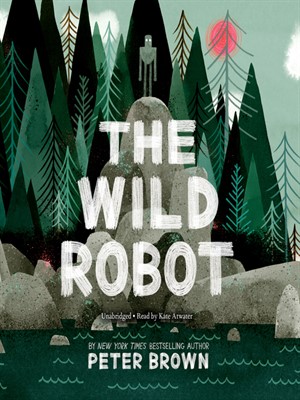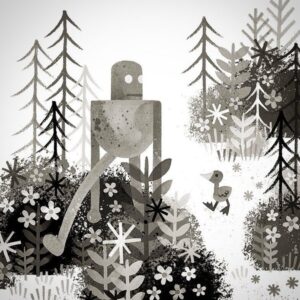 The Wild Robot
The Wild Robot
By Peter Brown
Little, Brown & Company
$16.99
ISBN: 978-0-316-38199-4
Ages 9-12
On shelves now
There are far fewer robot middle grade books out there than you might expect. This is probably because, as a general rule, robots fall into the Data from Star Trek trap. Their sole purpose in any narrative is to explain what it is to be human. You see this all the time in pop culture, so it stands to reason you’d see it a bit in children’s books too. Never you mind that a cool robot is basically a kid’s dream companion. Take away the kid, put the robot on its own, and you have yourself some philosophy lite. Maybe that’s why I liked Peter Brown’s The Wild Robot as much as I did. The heroine of this book is mechanical but she’s not wrestling with the question of what it means to feel emotions or any of that. She’s a bit more interested in survival and then, after a bit of time, connection. Folks say this book is like Hatchet or My Side of the Mountain. Maybe so, but it’s also a pretty good book about shedding civilization and going wild. In short, living many a city kid’s dream.
The first thing she is aware of is that she is bound in a crate by cords. Once those are severed she looks about. Roz is a robot. She appears to be on an island in the sea. Around her are the shattered remains of a good many other robots. How she has gotten here, she doesn’t know, but it doesn’t take long for her to realize that she is in dire need of shelter and allies. Roz is not a robot built for the outdoors, but part of her programming enables her to adapt. Learning the languages of the denizens of the forest, Roz is initially rebuffed (to put it mildly) by the animals living there. After a while, though, she adopts a gosling she accidentally orphaned and together they learn, grow, and come to be invaluable members of the community. And when Roz faces a threat from the outside, it’s her new friends and extended family that will come to her aid.
 They say that all good stories can be easily categorized into seven slots. One of the best known is “a stranger comes to town”. Roz is precisely that and her story is familiar in a lot of ways. The stranger arrives and is shunned or actively opposed. Then they win over the local populace and must subsequently defend it against an incoming enemy or be protected by it. But there is another kind of book this conjures up as well. The notion of going from “civilized” to “wild” carries the weight of all kinds of historical appropriations. Smart of Brown then to stick with robots and animals. Roz is a kind of anti-Pinocchio. Instead of trying to figure out how to fit in better with civilization, she spends the bulk of her time trying to figure out how to shed it like a skin. In his career, Brown has wrestled continually with the notion of civilization vs. nature, particularly as it relates to being “wild”. The most obvious example of this, prior to The Wild Robot, was his picture book Mr. Tiger Goes Wild. Yet somehow it manages to find its way into many of the books he does. Consider the following:
They say that all good stories can be easily categorized into seven slots. One of the best known is “a stranger comes to town”. Roz is precisely that and her story is familiar in a lot of ways. The stranger arrives and is shunned or actively opposed. Then they win over the local populace and must subsequently defend it against an incoming enemy or be protected by it. But there is another kind of book this conjures up as well. The notion of going from “civilized” to “wild” carries the weight of all kinds of historical appropriations. Smart of Brown then to stick with robots and animals. Roz is a kind of anti-Pinocchio. Instead of trying to figure out how to fit in better with civilization, she spends the bulk of her time trying to figure out how to shed it like a skin. In his career, Brown has wrestled continually with the notion of civilization vs. nature, particularly as it relates to being “wild”. The most obvious example of this, prior to The Wild Robot, was his picture book Mr. Tiger Goes Wild. Yet somehow it manages to find its way into many of the books he does. Consider the following:
• My Teacher Is a Monster! (No, I Am Not) – A child sees his teacher as a creature best befitting a page in “Where the Wild Things Are” until, by getting to know her, she is humanized in his sight.
• Children Make Terrible Pets – A bear attempts to tame a wild human child with disastrous results.
• The Curious Garden – Nature reclaims abandoned civilization, and is tamed in the process.
• Creepy Carrots – Brown didn’t write this one but it’s not hard to see how the image of nature (in the form of carrots) terrorizing a bunny in his suburban home could hold some appeal.
• Even the Chowder books and his first picture book The Flight of the Dodo had elements of animals wrestling with their own natures.
In this book, Brown presents us with a robot created with the sole purpose of serving in a domestic capacity. Are we seeing only the good side of nature and eschewing the terrible? Brown does clearly have a bias at work here, but this is not a peaceable kingdom where the lamb lays down next to the lion unless necessity dictates that it do so. Though the animals do have a dawn truce, Brown notes at one moment how occasionally one animal or another might go missing, relocating involuntarily to the belly of one of its neighbors. Nasty weather plays a significant role in the plot, beaching Roz at the start, and providing a winter storm of unprecedented cruelty later on. Even so, those comparisons of this book to Hatchet and My Side of the Mountain aren’t far off the mark. Nature is cold and cruel but it’s still better than dull samey samey civilization.
 Of course, you read every book through your own personal lens. If you’re an adult reading a children’s book then you’re not only reading a book through your own lens but through the lens you had when you were the intended audience’s age as well. It’s sort of a dual method of book consumption. My inner ten-year-old certainly enjoyed this book, that’s for sure. Thirty-eight-year-old me had a very different reaction. I liked it, sure I did. But I also spent much of this book agog that it was such a good parenting title. Are we absolutely certain Peter Brown doesn’t have some secret children squirreled away somewhere? I mean, if you were to ask me what the theme of this book truly is, I’d have to answer you in all honesty that it’s about how we see the world anew through the eyes of our children. A kid would probably say it’s about how awesome it is to be a robot in the wild. Both are true.
Of course, you read every book through your own personal lens. If you’re an adult reading a children’s book then you’re not only reading a book through your own lens but through the lens you had when you were the intended audience’s age as well. It’s sort of a dual method of book consumption. My inner ten-year-old certainly enjoyed this book, that’s for sure. Thirty-eight-year-old me had a very different reaction. I liked it, sure I did. But I also spent much of this book agog that it was such a good parenting title. Are we absolutely certain Peter Brown doesn’t have some secret children squirreled away somewhere? I mean, if you were to ask me what the theme of this book truly is, I’d have to answer you in all honesty that it’s about how we see the world anew through the eyes of our children. A kid would probably say it’s about how awesome it is to be a robot in the wild. Both are true.
If you’re familiar with a Peter Brown picture book then you might have a sense of his artistic style. His depiction of Roz is very interesting. It was exceedingly nice to see that though the book refers to her in the feminine, it’s not like the pictures depict her as anything but a functional robot, glowing eyes and all. Even covered in flowers she looks more like an extra from Miyazaki’s Castle in the Sky than anything else. Her mouth is an expressionless slit but in her movements you can catch a bit of verve and drive. Alas, the illustrations are in black and white and not the lovely color of which we know Brown to be capable. Colored art in middle grade novels is a pricey affair. A publisher needs to really and truly believe in a book to give it color. That said, with this book appearing regularly on the New York Times bestseller list, you’d think they’d have known what they had at the time. Maybe we can get a full-color anniversary edition in a decade or so.
 Like most robot books, Brown does cheat a little. It’s hard not to. We are told from the start that Roz is without emotions, but fairly early on this statement is called into question. One might argue quite reasonably that early statements like. “As you might know, robots don’t really feel emotions. Not the way animals do.” Those italics at the beginning of the sentence are important. They suggest that this is standard information passed down by those in the know and that they believe you shouldn’t question it. But, of course, the very next sentence does precisely that. “And yet . . .” Then again, those italics aren’t special to that chapter. In fact, all the chapters in this book begin with the first few words italicized. So it could well be that Brown is serious when he says that Roz can’t feel emotions. Can she learn them then? The book’s foggy on that point, possibly purposely so, but in that uncertainty plenty will find Brown’s loving robot a bit more difficult to swallow than others. Books of this sort work on their own internal logic anyway. I know one reader who seriously wondered why the RECO robots had no on/off switches. Others, why she could understand animal speech. You go with as much as you can believe and the writer pulls you in the rest of the way.
Like most robot books, Brown does cheat a little. It’s hard not to. We are told from the start that Roz is without emotions, but fairly early on this statement is called into question. One might argue quite reasonably that early statements like. “As you might know, robots don’t really feel emotions. Not the way animals do.” Those italics at the beginning of the sentence are important. They suggest that this is standard information passed down by those in the know and that they believe you shouldn’t question it. But, of course, the very next sentence does precisely that. “And yet . . .” Then again, those italics aren’t special to that chapter. In fact, all the chapters in this book begin with the first few words italicized. So it could well be that Brown is serious when he says that Roz can’t feel emotions. Can she learn them then? The book’s foggy on that point, possibly purposely so, but in that uncertainty plenty will find Brown’s loving robot a bit more difficult to swallow than others. Books of this sort work on their own internal logic anyway. I know one reader who seriously wondered why the RECO robots had no on/off switches. Others, why she could understand animal speech. You go with as much as you can believe and the writer pulls you in the rest of the way.
I’ve read books for kids where robots are in charge of the future and threaten heroes in tandem with nature. I’ve read books for kids where robots don’t understand why they’re denied the same rights as the humans around them. I even read a book once about a robot who tended a human child, loving her as her parents would have, adapting her to her alien planet’s environment over the years (that one’s Keeper of the Isis Light by Monica Hughes and you MUST check it out, if you get a chance). But I have never read a robot book quite as simple and to the point as Peter Brown’s. Nor have I read such comforting bedtime reading in a while. Lucky is the kid that gets tucked in and read this at night. An excellent science fiction / parenting / adventure / survival novel, jam packed with robotic bits and pieces. If this is the beginning of the robot domination, I say bring it on.
On shelves now.
Source: Final copy sent from publisher for review.
Like This? Then Try:
- Iron Giant by Ted Hughes
- Robot Dreams by Sara Varon
- Keeper of the Isis Light by Monica Hughes



What a spot on essay – I like how you come at the book from multiple angles. I, too have been thinking about Peter Brown’s long meditation on wildness and our relationship to it. Thank you!
Kids are loving this book. I wonder if others will find it distinguished.